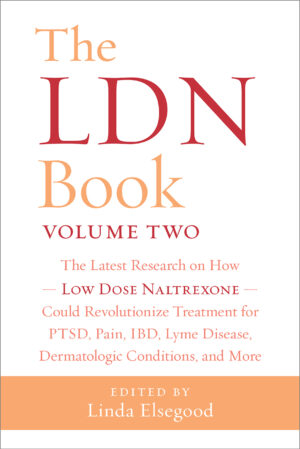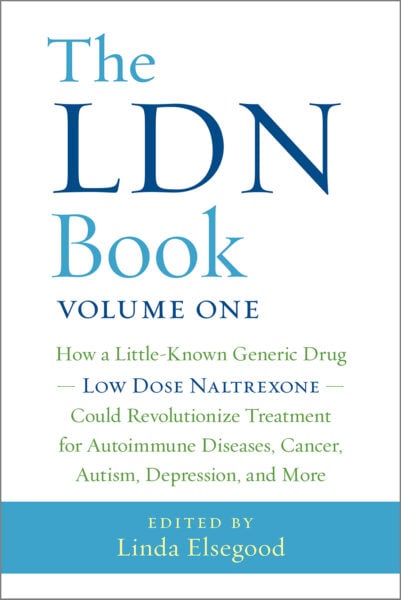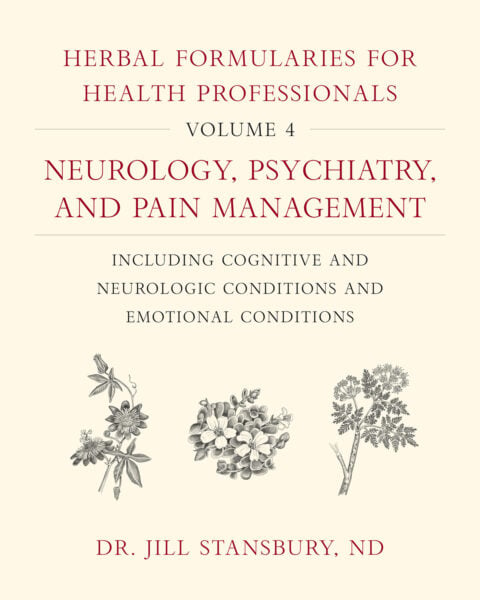Chronic Skin Conditions: A New Approach to Treatment

A drug that is simultaneously affordable, devoid of severe side effects, and applicable to a wide range of diseases is not often found in the modern pharmaceutical landscape. But as medical professionals and researchers alike continue to discover, Low Dose Naltrexone (LDN) boasts this remarkable combination.
LDN, originally prescribed in higher doses as a treatment for opioid addiction, works by blocking opioid receptors, thereby stimulating the production of endorphins, mitigating the inflammatory process, and stabilizing the immune response. Prescribed off-label and administered in small daily doses, this generic drug has proven useful in treating many different ailments including many chronic dermatologic conditions.
The following excerpt is from The LDN Book, Volume Two by Linda Elsegood. It has been adapted for the web.
Treating Skin Conditions
All chronic skin conditions are associated with inflammation and/or immune system dysfunction at some level. The specific patterns of inflammation and immune dysregulation differ among disorders related to skin, hair, and nails, but many share similar pathways. Low dose naltrexone (LDN) has been shown to influence both inflammation and immune dysregulation at multiple levels.
This, along with the very low side effect profile, makes it an ideal option for patients with a variety of skin diseases. It has been suggested that LDN could be helpful for a number of dermatologic conditions, including alopecia areata and variants, atopic dermatitis, autoimmune-related skin disorders (sclerosis/morphea, lupus, dermatomyositis, et cetera), pemphigus, pemphigoid, psoriasis, lichen planus, lichen sclerosis, pruritus, prurigo nodules, Hailey-Hailey, autoimmune scarring hair loss, vitiligo and pyoderma gangrenosum, among others.
At this point there are very few reports in the literature demonstrating the effectiveness of LDN for dermatology patients. Those that do exist consist of case studies, case series, and reviews.
 While we generally think of opioid receptors being primarily in the central and peripheral nervous system, they also have important roles within the immune system, the skin, and various other organs.
While we generally think of opioid receptors being primarily in the central and peripheral nervous system, they also have important roles within the immune system, the skin, and various other organs.
The three predominant types of opioid receptors—mu, delta, and kappa—are transmembrane receptors that are linked to a variety of regulatory enzymes, including adenylyl cyclase—a ubiquitous cellular regulatory enzyme—and to calcium channels, which are essential for maintaining a calcium gradient within all cells that controls a wide variety of cellular processes.1
Mu, delta, and kappa opioid receptors can be found in varying concentrations on epidermal keratinocytes, epidermal melanocytes, fibroblasts, and peripheral nerve fibers.2
Within the skin opioid receptors are more concentrated in the basal layer and just above the basal layer, but can be found throughout the epidermis.3 Interestingly, there are several skin conditions in which we find altered expression of epidermal mu receptors. These include psoriasis, basal cell cancer, and chronic wounds.4
This supports data suggesting that opioid receptors and opioids play an important role in epidermal cell proliferation and differentiation.5
Opioid receptors are present on the surface of keratinocytes and help regulate intercellular adhesion and keratinocyte migration.6 They have also been shown to be involved in maintaining proteins—including involucrin, loricrin, and filaggrin—that are crucial to the integrity of the stratum corneum.7
Other important roles that opioids and opioid receptors play in the skin include regulation of pain and itch—especially in chronic dermatoses— melanin production, and sebum production. The mu receptor, in particular, also appears to be involved in melanocyte proliferation.8
Additionally, opioids and their receptors regulate functions of a variety of types of cells involved in the immune response, including dendritic cells, macrophages, mast cells, lymphocytes, and polymorphonuclear leukocytes (neutrophils, eosinophils, and basophils).9
 One of the particularly interesting things about naltrexone is that it can interact with other receptors as well. The toll-like receptor (TLR) family is a group of proteins found in both plants and animals that plays an important role in immunity.
One of the particularly interesting things about naltrexone is that it can interact with other receptors as well. The toll-like receptor (TLR) family is a group of proteins found in both plants and animals that plays an important role in immunity.
These receptors help the body identify pathogenic microbes, initiate an appropriate immune response, and distinguish the “bad” from the “good” when it comes to bacteria, yeast, fungi, and viruses.10
The immune system is tightly involved in inflammation, so it follows that by interacting with these important immune system receptors, receptor ligands can impact inflammatory pathways.
Naltrexone has been shown to decrease tumor necrosis factor alpha (TNF-a), as well as other inflammatory compounds, including interleukin (IL) 6, nitric oxide, and nuclear factor kappa B (NF-kB) via interacting with TLR-4.11
It is likely that naltrexone interacts with other TLRs as well. Given what we know about the mechanisms of action of naltrexone and LDN, it is clear that there are several points at which it can impact inflammation and immune system function, making it potentially incredibly useful in the treatment and management of skin diseases.
Data regarding the effectiveness of LDN for the treatment of dermatologic conditions is limited. Given the known mechanisms of action, topical or systemic LDN should be helpful in a wide variety of inflammatory and autoimmune skin diseases. I have used LDN successfully to treat alopecia areata, vitiligo, and localized morphea.
I also use LDN for people with a history of melanoma to potentially prevent the development of new melanomas and to limit recurrence/metastasis. Additionally, there is promising data indicating that LDN will likely be effective for treating chronic wounds and diabetes-related skin disorders.12
Due to the safety and low side effect profile, LDN could be considered as an initial option—especially for people who either can’t use standard medications or want to avoid the toxicity of some of the drugs commonly used for chronic skin conditions.
When deciding on a treatment plan that includes LDN, it is important to screen for thyroid disease and opioid use (prescription and recreational).
It is also important to take into account the patient’s other health issues—if they have fibromyalgia, inflammatory bowel disease, other autoimmune conditions, or depression/anxiety, LDN is an especially good option. Hopefully, as LDN becomes more widely understood and accepted, more and better data will be collected regarding its use in treating disorders of the skin.
- I. S. Zagon et al., “The Biology of the Opioid Growth Factor Receptor,” Brain Research Reviews 38 (2002): 351–76.
- P. L. Bigliardi et al., “Opioids and the Skin, Where Do We Stand?,” Experimental Dermatology 18, no. 5 (May 2009): 424–30.
- P. L. Bigliardi et al., “Specific Stimulation of Migration of Human Keratinocytes by Mu Opiate Receptor Agonists,” Journal of Receptors and Signal Transduction 22 (2012): 191–99.
- M.Bigliardi-Qietal.,“Beta-Endorphin Stimulates Cytokeratin 16 Expression and Downregulates Mu Opiate Receptor Expression in Human Epidermis,” Journal of Investigative Dermatology 114 (2000): 527–32; M. Bigliardi-Qi et al., “Characterization of Mu Opiate Receptor in Chronic and Acute Wounds and the Effect of Beta-Endorphin on Transforming Growth Factor Beta Type II Receptor and Cytokeratin 16 Expression,” Journal of Investigative Dermatology 120 (2003): 145–52.
- Bigliardi et al., “Specific Stimulation of Migration of Human Keratinocytes.”
- P. L. Bigliardi et al., “Activation of the Delta Opioid Receptor Promotes Cutaneous Wound Healing by Affecting Keratinocyte Intercellular Adhesion and Migration,” British Journal of Pharmacology 172 (2015): 501–14.
- P. L. Bigliardi et al., “Opioids and Skin Homeostasis, Regeneration and Ageing—What’s the Evidence?,” Experimental Dermatology 6, no. 25 (2016): 586–91.
- P. L. Bigliardi and M. Bigliardi-Qi, “Peripheral Opioids,” in E. A. Carstens and T. Akiyama, Itch: Mechanisms and Treatment (Boca Raton, FL: CRC Press, 2014); S. Kauser et al., “Regulation of Human Epidermal Melanocyte Biology by Beta- Endorphin,” Journal of Investigative Dermatology 120 (2003): 173–80.
- F. Yuan, H. Xiaozhou, Y. Yilin, et al., “Current Research on Opioid Receptor Function,” Current Drug Targets 13, no. 2 (February 2012): 230–46.
- Z. Dembic, “The Function of Toll-Like Receptors,” Madame Curie Bioscience Database, Landes Bioscience (2000–13).
- D.K. Patten et al.,“The Safety and Efficacy of Low Dose Naltrexone in the Management of Chronic Pain and Inflammation in Multiple Sclerosis, Fibromyalgia, Crohn’s Disease and Other Chronic Pain Disorders,” Pharmacotherapy 38 (2018): 382–89.
- P. J. McLaughlin, J. A. Immonen, and I. S. Zagon, “Naltrexone Accelerates Full-Thickness Wound Closure in Type 1 Diabetic Rats by Stimulating Angiogenesis,” Experimental Biology and Medicine 238, no. 7 (July 2013): 733–43.
Reccomended Reads
Recent Articles
Garlic mustard: while known as “invasive,” this plant can be consumed in its entirety and has great nutritional value. Plus, the garlic-flavor is a perfect addition to any recipe that calls for mustard! The following are excerpts from Beyond the War on Invasive Species by Tao Orion and The Wild Wisdom of Weeds by Katrina…
Read MoreMany know the effects of catnip on our feline friends, but few realize that catnip has medicinal effects for humans. From stomach aches to reducing fevers, catnip is a versatile herb with many benefits. The next time you grow this plant for your cat you may end up taking a few cuttings for yourself! The…
Read MoreWhether you’re looking to replace your end-of-the-day cocktail, relax before bed, or want something new to add to your tea, this non-alcoholic mocktail syrup base will do the trick. Delicious and all-natural, take a sip of this nightcap mocktail and feel your troubles melt away. The following is an excerpt from Herbal Formularies for Health…
Read MoreSurprisingly, medicine can actually be delicious. This anti-inflammatory smoothie uses natural (and tasty!) ingredients to help reduce inflammation caused by any number of circumstances. The following is an excerpt from Herbal Formularies for Health Professionals, Volume 4 by Jill Stansbury. It has been adapted for the web. RECIPE: Ginger and Pineapple Anti-Inflammatory Smoothie This is an all-purpose…
Read MoreMake your own delicious, healthy, probiotic sauerkraut! Four easy steps are all you need to turn fresh garden veggies into a long-lasting, tangy, pungent condiment. The following excerpt is from The Art of Fermentation by Sandor Ellix Katz. It has been adapted for the web. 4 Simple Steps to Making Sauerkraut The English language does…
Read More









